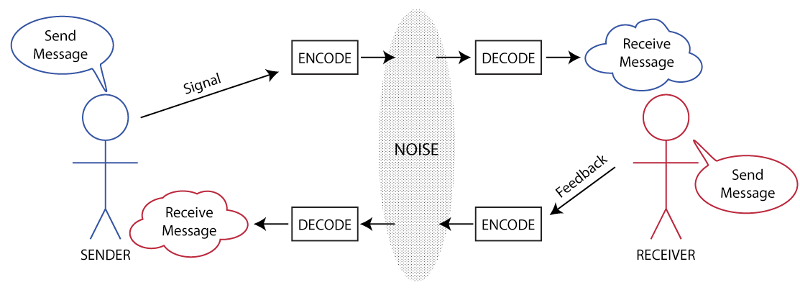iStudy for Success!
Online learning tutorials for essential college skills.
Active Listening
iStudy would like to acknowledge Stephanie Flanagan for revising the content of this module.
Purpose
.jpg) Active listening is a communication skill that you can use to improve your ability to understand and comprehend verbal information. This skill will also help you to communicate your ideas and knowledge more effectively. In this tutorial, you will learn about effective active listening skills. You will understand how the communication process actively involves a sender and a receiver.
Active listening is a communication skill that you can use to improve your ability to understand and comprehend verbal information. This skill will also help you to communicate your ideas and knowledge more effectively. In this tutorial, you will learn about effective active listening skills. You will understand how the communication process actively involves a sender and a receiver.
Whether our roles are as students, friends, workers, or family members we spend a lot of time communicating. To communicate well, we have to listen well. We often just hear words and don't really listen carefully or critically. Active and careful listening shows our sensitivity to others. It is a critical part of paying attention to other people and being mindful of life's basic and substantive issues.
Goals and Objectives
The overall goal of this tutorial is to help you to become an active listener. Upon completion of this tutorial, you will be able to:
- Define active listening and its relationship to communication
- Describe active listening skills and their components
- Engage in and model active listening skills
Activities
Read the materials about active listening, and complete the activities.
- Information about Active Listening
- Activity 1: What is Active Listening?
- Feedback in Active Listening
- Activity 2: Ways of Responses
- Cue Words and Running Interferences
Note: All external links in this tutorial will open in a new window or tab.
References
Summary
Instructor's Guide
Information about Active Listening
Defining Active Listening
The concept of active listening used in this tutorial can be described as a communication skill that involves both the sender and the receiver in the communication process. Some people would say that communication doesn't exist without the involvement of at least one active sender and one active receiver. Once a message is "sent," it may pass through "noise" that distorts the message. A receiver tries to understand what the sender's message or expression of feelings means. After receiving a message, an active receiver puts his or her understanding of the message into his or her own words (paraphrases) and returns it as feedback for the sender's verification.

Shannon-Weaver Communication Model
General Guidelines
- If you use phrases like, "I think," "I feel," it means that you weren't really listening or at least you aren't responding to the content of what the other person is saying. In other words, you are reacting to, rather than responding to a question or comment.
- As a listener, paraphrasing would be helpful to indicate that you understood the message. Put it in your own words and check it out with the person who sent the message.
- Use feedback to verify the message with the sender. Feedback is most useful at the earliest opportunity after a statement has been made or a behavior exhibited, but you still need to wait for the speaker to indicate that he wants your feedback.
Activity 1: What is Active Listening?
Take the short quiz below to see if you understand about active listening so far.

Feedback in Active Listening
Definition of Feedback
Feedback is a key component of active listening. Feedback can be a corrective mechanism for helping an individual learn how well his or her behavior matches the original intention. It can also be a means of establishing one's identity.
Feedback helps another person to consider changing behavior or altering a message. It is communication with a person (group) that gives that person information about how he or she affects others. Feedback helps an individual stay "on target" and thus better achieve a goal or purpose.
An active listener must be solicited for a response by the sender and must refrain from imposing uninvited responses. Feedback is most useful when the sender asks for response by formulating a question that a listener can answer.
Tips for Providing Feedback
Here are some "tips" that will help you respond appropriately during active listening. In general, you should use language that:
- Objectively describes another person's message, behavior, or situation. Feedback must be specific rather than general.
- Describes how the other person's behavior, message, or situation concretely affects your life. Feedback must be directed toward something the receiver can do to change the situation. Frustration results when a person is reminded of shortcomings over which he or she has no control.
- Describes your own feelings and avoids evaluative language. By describing your own reactions, an individual is free to use, or not use, the feedback you offer. Avoiding evaluative language reduces the likelihood that an individual will react defensively. Feedback must take into account the needs of both the giver and the receiver.
- Describes what you want the other person to do. For example, offer an explanation, change behavior, or provide suggestions for solving a problem.
Other ways of responding appropriately relate to the verbs you choose in your response. For example:
- Use "I want" statements such as: "I want you to do this."
- Effects: Helps clarify what you really want for yourself and for others.
- Use "I feel" statements such as: "I feel X when you do Y."
- Effects: These statements help express feelings without attacking the self-esteem of another person. When expressing irritation, for example, first describe the specific behavior, and then express your feelings.
- Use mixed feeling statements:
- Effects: Mixed feeling statements express positive and negative feelings at the same time. They allow time for an individual to respond after you express the first feeling. Express positive feelings first, give an individual time to respond, and then express negative feelings.
- Use empathic feeling statements:
- Effects: Empathic feeling statements do more than just express your wants and feelings by conveying sensitivity toward others. Avoid using the statement, "I know how you feel," because it denies the other person his or her feelings.
- Use confrontational statements for discrepancies:
- Effects: Confrontation is appropriate when there are discrepancies. For instance, when another person's words contradict what he or she does. Another example would be when there is a conflict between a job description and what is being asked of someone in a job.
Activity 2: Ways of Responses
Take the short quiz below to check if you understand what different kinds of statements sound like.

Cue Words and Running Interferences
Cue words will help you to categorize and understand the content of what you are hearing. Hearing these types of words, after some practice in listening for them, will help trigger the process that allows you to sort out the content. The cue words to look for can be broken down into several general areas.
Cue Word Trigger Words
- Perception - Observe, notice, detect, picture, see, hear, touch, feel, taste, smell
- Induction - Qualities, rule, pattern, generalization, on the whole, common elements, common characteristics
- Analysis - List, outline, classify, reasons, parts, sort, define, sequence, categorize, analyze, factors, procedures, steps
- Same/Different - Compare, contrast, differentiate, same, different, alike, similar
- Insight - Inference, realization, overlapping pattern, connection, parallel pattern, infer, relationship
- Appraisal - Weigh, grade, rate, prioritize, appraise, rank by value such as best-to-worst or most-to-least
- Summary - Main idea, condense, main point, reduce, summary, sum up, focus, in a nutshell, summarize
- Evaluation - Belief, judge, viewpoint, decide, opinion, evaluate, believe, critique
- Idea - Ideas, goals, options, changes, ways, possibilities, opportunities
- Prediction - Predict, forecast, hypothesize, consequences, affect, effects, happen
- Action - Apply, build, do, use, write, graph
Running Interference(s)
Do you occasionally find you are so concerned with formulating a response that you aren't really listening to the the person who is speaking? Some of us get so eager, or so anxious, about preparing a reply or anticipating a change in the focus of attention toward ourselves that we lose the message and completely forget that someone else is speaking.
Mental and physical circumstances can also interfere with active listening. These may include items such as the following:

Personal thought processes:
- Daydreaming
- Mind reading - Anticipating what might be said
- Rehearsing - Your responses
These can block reception of the total content of the message being sent.

Emotional involvement with the topic:
- Identifying
- Judging
- Advising
- Sparring
- Being right
- Derailing
- Placating
- Preconceived view of the speaker
These can make you filter what you hear and block reception of the total content of the message being sent.

Physical needs:
- Hunger
- Thirst
- Needing a bathroom
- Too many adult beverages the night before
- White noise or facilities that are inappropriate for group needs
If possible, try to choose a room for group meetings where white noise or background noise is kept to a minimum. Also, look for a room that fits the size of the group, where the chairs are comfortable, and where everyone can maintain eye contact.
References
Content
- Alvarez, P. J. (1994). The CalREN Project Study Tips. Student Learning Center, University of California, Berkeley. Retrieved July 29, 2017, from http://slc.berkeley.edu/studystrategies/acadsuccess_resources.htm
- Benjamin, D. (1996). Developing "Active Listening" Skills I. Litigation and Trial Support Services for Physicians, Risk Managers, and Attorneys. Retrieved April 8, 2002, from http://www.channel1.com/ *
- Dunnigan, T. (1997). Help for families: Active listening lesson . Retrieved 1998, from http://home1.gte.net/dunnigan/ *
- Osif, B. (1996). Teaching research Skills: Innovative strategies for library use instruction. Special Libraries Association, Transportation Division. University of Minnesota. (1997).
- Pearls of Wisdom: Leaderly Listening. Retrieved July 28, 2017, from http://www.pearlofwisdom.org/LeaderlyListenings.html
- The University of Minnesota Duluth. (2002): Listening Skills, Student Handbook for Currently Enrolled Students. Retrieved July 28, 2017, from http://www.d.umn.edu/student/loon/acad/strat/ss_listening.html
- Wells, G. (1987). Effective Listening. Academic Advising Services, College of St. Benedict/St. John's University
* Indicates that the original Website is no longer available.
Image Credits
Deer
- Source: http://commons.wikimedia.org/wiki/
- File: Young_kudu_with_big_ears_(Kenya).jpg
- This file is licensed under the Creative Commons Attribution 2.0 Generic license.
Summary
Active listening involves communication between two or more people. There is a sender and a receiver in all communication. Active listeners should focus on the content of the message, not on reactions to the message. The receiver should use feedback to verify that the message is understood correctly. As you finish this tutorial, here is a summary of the responsibilities and benefits of listening actively. When active listening skills are used the listener:
- Takes responsibility for understanding the message
- Understands that others have the right to be heard
- Is encouraged to resolve conflicts and prevent miscommunication
- Learns how to listen to new thoughts and ideas
- Provides, and accepts, feedback
- Understands that active listening requires time and effort
- Understands and deals with negative feelings
As a result:
- Everyone's self-esteem is raised
- Good group relations are promoted
Active Listening Tips
Active Listening uses:
- focus on the content of the message, not reactions
- feedback to verify the messages
Tips for Responding During Active Listening
- Objectively describes another person's message, behavior, or situation. Feedback must be specific rather than general.
- Describes how the other person's behavior, message, or situation concretely affects your life. Feedback must be directed toward something the receiver can do about the situation. Frustration results when a person is reminded of shortcomings over which he or she has no control.
- Describes your own feelings and avoids evaluative language. By describing your own reactions, an individual is free to use, or not use, the feedback you give. Avoiding evaluative language reduces the likelihood that an individual will react defensively. Feedback must take into account the needs of both the giver and the receiver.
- Describes what you want the other person to do. For example, offer an explanation, a suggested change of behavior, or provide suggestions for solving a problem.
Making Effective Statements
- Use "I want" statements such as, "I want you to do this."
- Use "I feel" statements such as, "I feel X when you do Y."
- Use "mixed feeling" statements
- Use "empathic feeling" statements
- Use "confrontational" statements for discrepancies
Instructor's Guide
Quizzes, Reflective Questions, and Activities
The following are the assignments embedded in the Active Listening tutorial:
- Activity 1: Quiz
- Activity 2: Quiz
Relationship to Other iStudy Tutorials
This tutorial is related to other iStudy tutorials on personal effectiveness, including note-taking, active reading, interview skills, conflict management, and peer tutoring. Therefore, it is recommended that instructors introduce this tutorial to students in conjunction with other personal effectiveness tutorials.
Suggested In-class Methods of Presentation
Lecture
- Explain the purpose/intent of the session. Refer to the Purpose section for more detail.
- Provide an introduction and overview of active listening, starting with a definition of the term:
- Active listening is a communication skill that involves both the sender and the receiver in the communication process. Some people would say that communication doesn't exist without the involvement of at least one active sender and one active receiver.
- Once a message is "sent," a receiver tries to understand what the sender's message or expression of feelings means. After receiving a message, an active receiver puts his or her understanding of the message into his or her own words (paraphrases) and feeds it back for the sender's verification - he or she feeds back how they understood the communication.
Discussion
Have students reflect in pairs about their listening skills. Plan an activity in which students take turns talking about themselves (an introduction, or perhaps their best and worst communication experiences). After the activity, ask students to recall as much as possible about what the other person said. Use this activity to make the following point:
- When you really listen to someone it is important to concentrate on the content of that message and the individual who is speaking. If you are thinking about the message in terms of "I think...," "I feel...," you are not focusing on what is being said. Instead you are reacting to the message.
Note: This is an excellent opportunity to utilize and reinforce the cooperative learning techniques found in the iStudy Cooperative Learning tutorial.
[top of page]
Key Points
These points are covered in the iStudy tutorial, but should be emphasized in any discussions.
Feedback is a key component of active listening. The instructor may want to stress the following:
- "Feedback" helps another person to consider changing behavior or altering a message. It is communication to a person (group) which gives that person information about how he or she affects others. Feedback helps an individual stay "on target" and thus better achieve a goal or purpose.
- Feedback is a corrective mechanism for helping an individual to learn how well his or her behavior matches the original intention.
- An active listener must be solicited for a response by the sender and must refrain from imposing uninvited responses. Feedback is most useful when the receiver has formulated the kind of question a listener can answer.
- Giving feedback involves responding to what the other person has said. The instructor may want to review some tips for how to respond effectively, and in a manner which promotes good interpersonal communication:
- Use language that objectively describes another person's message, behavior, or situation. The feedback must be specific rather than general.
- Describe how the other person's behavior, message, or situation concretely affects your life. Feedback must be directed toward something the receiver can do something about. Frustration results when a person is reminded of a short-coming over which he or she has no control.
- Describe your own feelings and avoid evaluative language. By describing your own reactions, an individual is free to use the feedback; or not as he or she sees fit. Avoiding evaluative language reduces the likelihood that an individual will react defensively. Feedback must take into account the needs of both the giver and the receiver.
- Describe what you want the other person to do. For example, provide an explanation, a suggested change of behavior, and/or offer suggestions for solving the problem.
- The instructor may want to review some tips for making effective statements:
- Use "I want" statements such as, "I want you to do this."
- Use "I feel" statements such as, "I feel X when you do Y."
- Use "mixed feeling" statements
- Use "empathic feeling" statements
- Use "confrontational" statements
[top of page]
Assessment Criteria
Through observing both the group's and the individual's activities, the instructor may assess student performance. Assessment criteria are as follows (instructors supply the percentage weights):
Assessment Criteria
|
Where
|
Domain
|
Activities
|
%
|
|
iStudy Tutorial
|
Knowledge
|
The student can define active listening by using and referring to its components.
|
|
|
iStudy Tutorial
|
Comprehension
|
The student can describe active listening skills by relating its components to communication.
|
|
|
In-Class
|
Application
|
The student can engage in active listening by participating in (group) discussion as listener and speaker.
|
|
|
iStudy Tutorial
|
Synthesis
|
The student can model active listening by giving examples or experiences (as well as by creating new problem situation and solution related to active listening.)
|
|
|
|
|
|
100%
|
.jpg) Active listening is a communication skill that you can use to improve your ability to understand and comprehend verbal information. This skill will also help you to communicate your ideas and knowledge more effectively. In this tutorial, you will learn about effective active listening skills. You will understand how the communication process actively involves a sender and a receiver.
Active listening is a communication skill that you can use to improve your ability to understand and comprehend verbal information. This skill will also help you to communicate your ideas and knowledge more effectively. In this tutorial, you will learn about effective active listening skills. You will understand how the communication process actively involves a sender and a receiver. 



